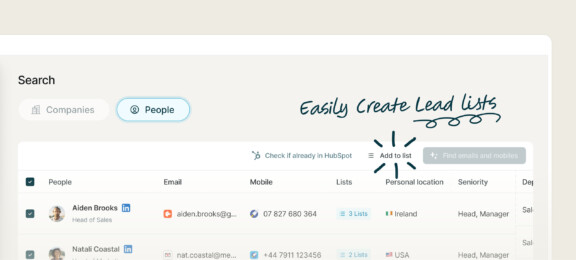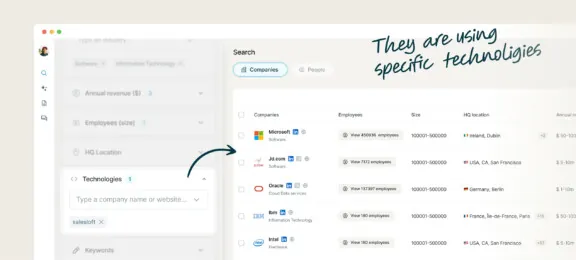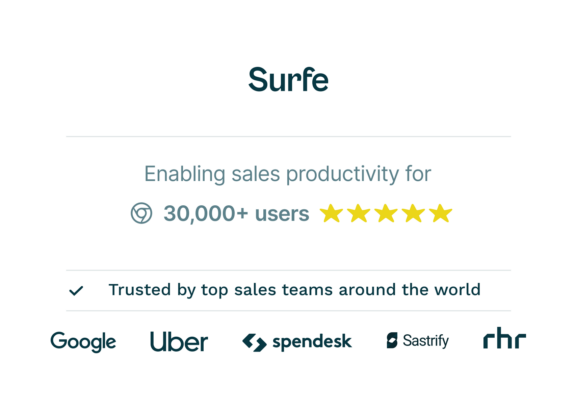Lead Segmentation: 10 Ways to Segment Your Leads into Lists
Have you ever received a present that’s clearly from the ‘emergency gift’ box?
Perhaps a pair of socks when you’re a self-proclaimed flip-flop enthusiast? Maybe a voucher for a BBQ restaurant when you’ve been vegetarian for 10 years? Or a right-handed pair of scissors when your entire personality is based on being left-handed?
Of course, it’s the thought that counts *said through gritted teeth*. But a gift that’s meant for you kind of takes the shine off the thought a little, right?
Well, that’s exactly how your leads feel when you don’t segment your leads into lists. Rather than crying in relief about finding a company that just gets them, they’re sitting scratching their heads and trying to figure out why they should care.
Segmentation – the process of dividing potential customers into groups based on specific criteria – helps you get intentional with your messaging. By narrowing down who you’re speaking to, you’ll be able to get more specific about what you have to say. And a personalized marketing strategy, friends, is what’s going to get you improved engagement and conversion rates, and better resource allocation too.
In this article, we’re going to jump into 10 – yes, 10! – different ways to segment your lists into different target account lists. Once you’ve picked your poison, we’ll talk about how to find leads who fit the bill. Here’s what we’re going to cover:
- Demographic Segmentation
- Firmographic Segmentation
- Behavioral Segmentation
- Psychographic Segmentation
- Technographic Segmentation
- Geographic Segmentation
- Engagement Level Segmentation
- Customer Journey Stage Segmentation
- Self-Segmentation
- Value-Based Segmentation
What is the best tool for segmenting your lead lists?
By the time you’ve finished reading, you’ll be a master of personalized marketing strategies. Let’s get started.
1. Demographic Segmentation
Let’s start off with demographic segmentation: grouping leads based on criteria like age, gender, income level, education, or location.
Let’s say you’re a fitness equipment company. You might choose to target professionals aged 25-45 in urban areas, to create campaigns that resonate with their busy, wellness-focused lifestyles.
Demographic segmentation allows you to speak directly to the unique needs and priorities of specific groups which in turn makes them feel understood. And when your leads feel understood, they’re more likely to engage – and your pipeline’s more likely to fill up.

2. Firmographic Segmentation
Segment by firmographics, and you’re categorizing your leads based on the characteristics of the business they work at. Think of it as the B2B equivalent of demographics – except instead of age or location, you’re looking at factors like company size, industry, or job title. This approach helps you fine-tune your messaging so it resonates with the unique needs of each business type.
Let’s say you sell a SaaS product. If it’s an enterprise solution, you’ll emphasize features like advanced integrations, customization abilities, and compliance. If it’s built for smaller businesses, you’ll probably talk more about affordability and ease of use.
By tailoring your messaging to specific firmographics, you make your outreach feel relevant and personalized. The CFO of a Fortune 500 company and the owner of a 10-person startup might both need your product – but their expectations, challenges, and decision-making processes are (hopefully for them) worlds apart. Segmenting your leads this way helps you tick both boxes, at the same time.
3. Behavioral Segmentation
Behavioral segmentation separates your leads based on what they do, not just who they are. By grouping leads based on how they interact with your brand, you can personalize the messaging and the timing of your outreach.
To segment by behaviour you’ll need to keep an eye on key criteria like website activity, email engagement, or purchase history.
Let’s say you notice a lead visiting your pricing page every day for a week – but never booking a demo. This behavior signals high intent. A smart salesperson might take this opportunity to nudge them along with a well-timed promotional offer or a case study that showcases ROI. On the other hand, leads who open your emails but don’t click through might need a softer approach, like a piece of original research to build trust.
The beauty of behavioral segmentation is that it allows you to meet your leads where they are in their journey. By aligning your content and timing with their actions, you’re offering the right solution at the right moment. And in B2B sales, that kind of relevance can be the difference between ‘maybe later’ and ‘let’s talk now’.
4. Psychographic Segmentation
Psychographic segmentation is about understanding what makes your leads tick. By grouping leads based on their values, interests, or lifestyles, you can tailor your messaging to connect with their motivations on a personal level.
For example, if you’re selling software with a sustainability focus, you might target environmentally conscious decision-makers who prioritize green initiatives. Messaging that highlights your product’s eco-friendly impact – like reducing paper waste or energy consumption – can resonate extremely well with their values. Tick!
The beauty of psychographic segmentation is that it taps into the ‘why’ behind purchasing decisions, and speak directly to what your leads care about most. Emotion is still very much a thing in a business context – and the companies that make it work for them are the ones that come out on top.
5. Technographic Segmentation
Technographic segmentation is categorizing leads based on their technology stack – like software preferences, hardware usage, or how quickly they adopt new tools.
For example, if you work for a SAAS business, knowing that a lead’s team already uses a specific CRM (say, Salesforce or HubSpot) gives you a huge advantage. You can highlight how your product integrates directly with their system – and makes using it better. Or if a lead is using outdated hardware, your pitch might focus on just how slick and easy-to-use your product is.
Why does this matter? Well, compatibility builds confidence. When leads see that your solution works with their current setup, it removes barriers and positions you as a practical choice.

6. Geographic Segmentation
Ok, we’re sure you can guess what geographic segmentation is (grouping leads based on a location like country, region, or city, for the uninitiated). It might seem a bit basic – but it’s actually a pretty clever way of sending timely outreach.
For example, if you’re targeting companies in Europe, you might highlight GDPR compliance in your messaging. Or offering region-specific promotions or events for leads in a particular city can make your outreach feel more relevant and personal.
If your business relies on fast shipping, geographic segmentation can also help you connect with leads who need quick fulfillment options, such as same day deliveries for urgent orders. By showing that you understand the challenges and priorities specific to their location, you’re making it crystal clear that your solution is built with them in mind.
7. Engagement Level Segmentation
Engagement level segmentation helps you meet your leads where they’re at. By grouping leads based on how they engage with your brand, you can make sure that your messaging always lands.
For example, new leads who’ve just signed up for your newsletter might benefit from an introductory email that highlights your value proposition. On the other hand, inactive users – those who haven’t opened an email or visited your site in months – could be re-engaged with a special offer. If you’ve got a super-engaged, active lead (lucky you!) they might appreciate advanced content like case studies or personalized recommendations to nudge them closer to a purchase.
By tailoring your outreach to each lead’s level of engagement, you’re not wasting time sending irrelevant messages – an email inviting a disengaged lead to book a demo, for example. Instead, everything you send will feel appropriate and, crucially, useful to your prospects.
8. Customer Journey Stage Segmentation
Segmenting leads by their stage in the customer journey makes sure you’re delivering the right message at the right time.
Leads in the awareness stage are just discovering the problem you solve, so they’ll respond well to educational content like blogs, whitepapers, or industry insights. Those in the consideration stage are actively evaluating options, making product comparisons or case studies more effective. For leads in the decision stage, it’s all about building confidence – using free trials, personalized demos, or testimonials from businesses similar to theirs.
Segmenting your leads by customer journey means guiding them toward conversion. For example, if a prospect is reading your ‘Top 10 Trends in B2B SaaS’ guide, they’re likely still in the awareness stage, so pitching your product directly might be premature. Instead, offering more resources to build trust is the smarter move. Later down the line, a lead who has requested a quote is clearly in the decision stage and ready for a tailored proposal.
By aligning your outreach with the lead’s buying stage, you avoid overwhelming or underserving your leads (which is a shortcut to losing the deal). Instead, you’re taking the approach of a helpful, trusted advisor – which is who most people will want to buy from.
9. Self-Segmentation
Now here’s one you might not have heard of. Feel free to tell us if we’re wrong. Self-segmentation lets leads tell you exactly what they’re interested in, and what stage they’re at. Gather preferences through opt-in forms or surveys, and you can create lists based on what’s come from the horses’ mouths.
This approach takes the guesswork out of segmentation, meaning you’ll be less likely to send the wrong message to the wrong person off the back of an assumption.
These don’t have to be a massive hassle to set up. For example, an opt-in form might ask leads to choose which topics interest them most – once they’ve made a selection, you’ve got a clear picture of how to nurture them.
The beauty of self-segmentation is its accuracy. Instead of relying solely on data you’ve observed, you’re acting on information your leads have provided. And when you follow up with content that matches their preferences, it shows you’re listening. Here you’re practicing good segmentation, but also giving the kind of personal touch that builds trust and keeps leads engaged in the long run.
10. Value-Based Segmentation
Value-based segmentation helps you to focus your time and resources where they’ll have the biggest impact. By categorizing leads based on their potential value, like estimated purchase capacity or lifetime value, you can prioritize high-value prospects – without leaving the others behind, of course.
For example, if you’ve identified a lead with the potential for a long-term, high-value contract, it makes sense to allocate more resources to building that relationship. This might mean offering them personalized demos, exclusive content, or direct access to a senior sales rep. A smaller-value lead might benefit from automated workflows or self-serve content that keeps them engaged without overloading your team.
The key benefit here is efficiency. By focusing your efforts on leads with the highest potential ROI, you’re setting yourself up to make the biggest possible impact. Tailoring your approach to each lead’s value also makes sure they receive the level of attention that makes sense for their needs.
What Is The Best Tool For Segmenting Your Lead Lists?
Woah – that was a long list! Hopefully you’re now brimming with ideas about how you can chop up your lead list and create deal-winning messages off the back of them.
If you just can’t wait to put your ideas into practice, we’ve got an idea 😉 If you want to actually find and segment your leads, you can use Surfe to search for prospects or companies based on specific segmentation approaches like firmographics, technographics, geographics, and more. You can create different lists for different segments, and enrich them with the contact data you need to. Now all that’s left to do is craft the perfect message.
Let’s Wrap It Up!
We can’t protect you from unwanted gifts – but we can protect you from sending unwanted messages. Segment your leads (final tip: if you want to get really good, try combining two or more different segmentation techniques), use Surfe to build your lists, and you’ll make sure every message you send hits the spot.
Now, anyone in the market for a pair of right-handed scissors?

Give the gift that keeps on giving*
*honestly, your messages will be so targeted your leads will think of them as a gift. Sign up here.
FAQs About Segmenting Your Leads Into Lists
What Is Lead Segmentation And Why Is It Important?
Lead segmentation is the process of dividing your leads into groups based on specific criteria, such as demographics, firmographics, behavior, or engagement level. This helps you tailor your messaging to the unique needs and interests of each group – and send more personalized and effective outreach as a result. By segmenting your leads, you should improve your engagement rates, increase conversion rates, and make better use of your time and resources.
How Can I Segment Leads Using Surfe?
Surfe makes lead segmentation simple and efficient. With Surfe, you can search for prospects or companies based on criteria like industry, location, or technology stack. Once you’ve found your leads, you can create tailored lists for each segment and enrich them with contact data. Clever!









